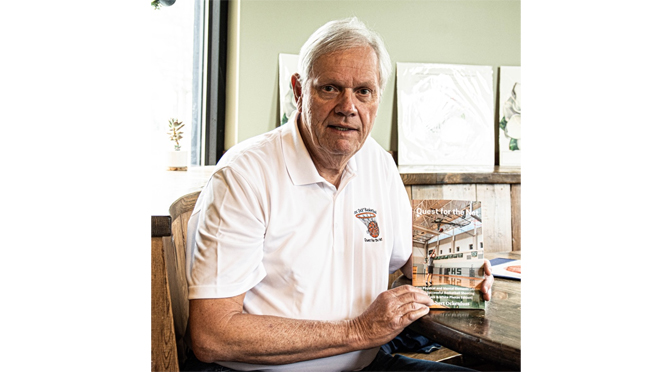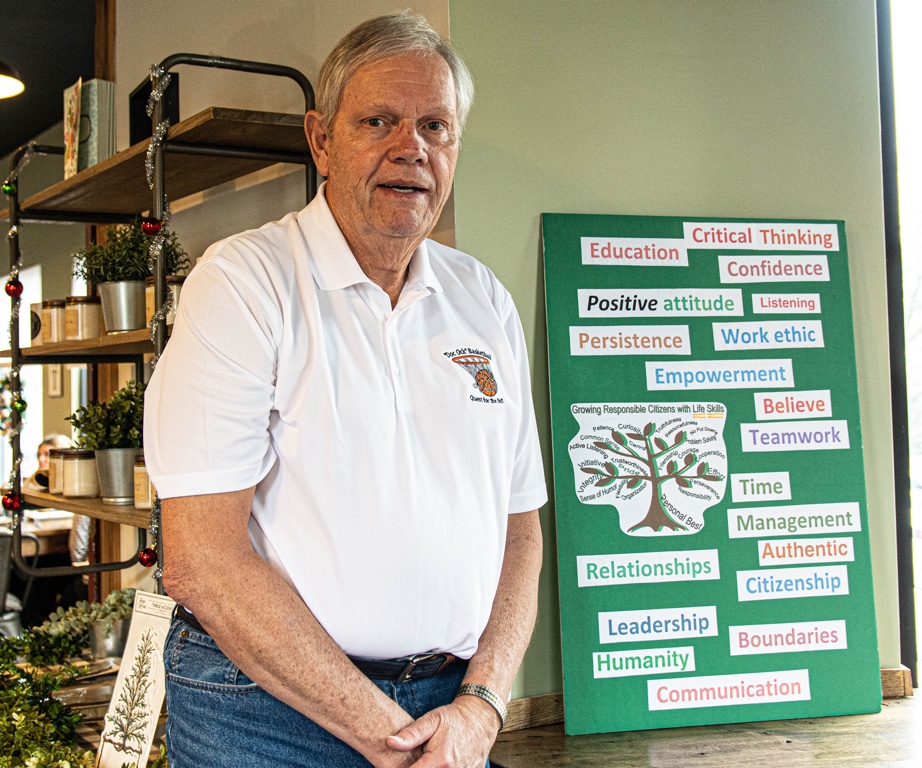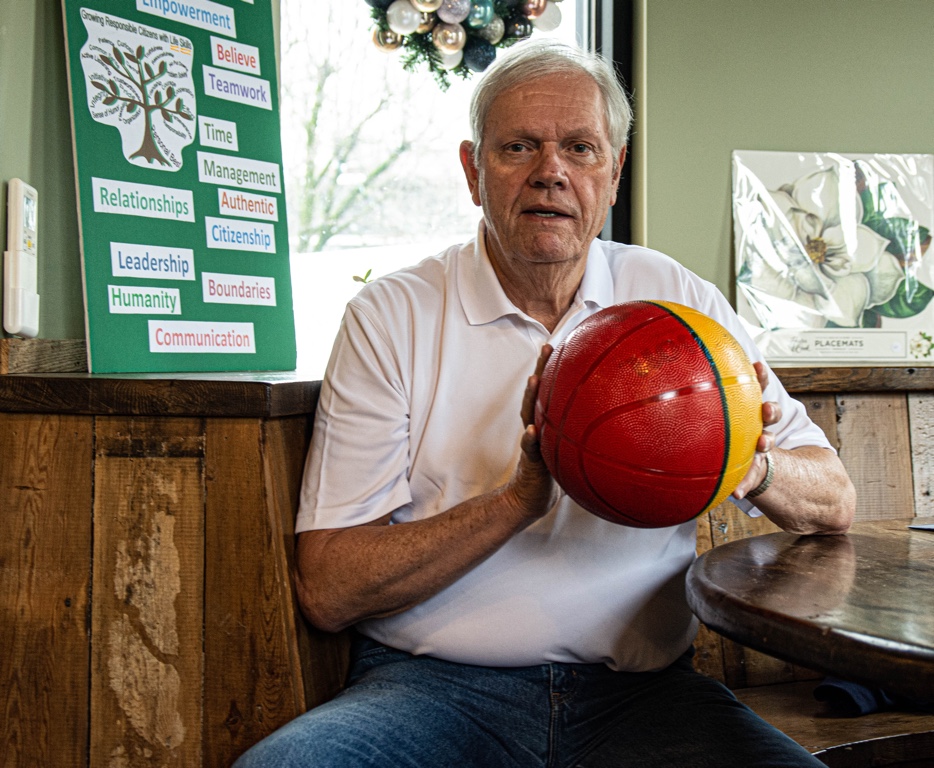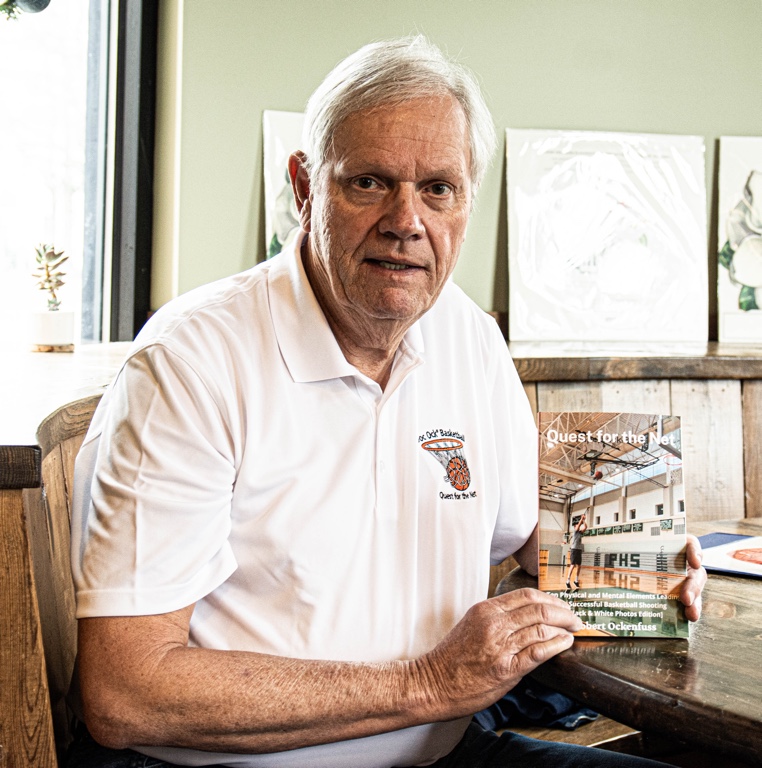|
|
Interview By: Diane Fleischman
There is no restaurant that serves basketballs on their menu, but recently, we had a chance to meet Robert Ockenfuss, a retired school teacher, basketball player and coach, who holds a very high respect and passion for the sport, as his mission continues as a teacher, with his published book, ‘Quest For The Net’, and an array of basketball clinics.
We’re over at the Rise and Grind in the heart of Perkasie, one of Ockenfuss’s favorite places to pick up some homemade crumb cakes and chocolate peanut butter square pastries. At the round table, the talk is all about basketball, power point presentations, posters, brochures, and of course, a few basketballs filled the table.
With a twinkle in his eyes, Ockenfuss was very eager to share some knowledge about why it is vital to have this information for any player of the game. And it was a pleasure to learn even more about his life as we proceeded with an interview.
TVL: Why did you move to Perkasie?
RO: My wife, Judy, and I moved to Perkasie in 1973, where I began to teach social studies at Central Junior High School within the Pennridge School District, and to coach high school basketball. We took a liking to the town from the moment we moved here. The people are friendly and it was a small town like East Hampton, Long Island, NY, the hometown where I grew up.
Judy and I have been married for 52 great years. She’s the love of my life! We have two great adult children, Amy and Rob!
TVL: That sounds like a great life! You’re retired now, what do you like to do for fun?
RO: I enjoy spending time with Judy. The New Jersey shore is a favorite destination. We love to travel to visit our son and daughter and grandkids. We’ve also been fortunate to take some great trips to the New England region, Florida, Phoenix, San Francisco, San Diego, Alaska, and Europe. We have also done several cruises. Perhaps several national parks are now on the bucket list.
Golf is my passionate hobby. I have played competitively within the Golf Association of Philadelphia, the Metropolitian Golf Association and in United States Golf Association events.
TVL: As you were growing up, why did you want to play basketball? What was the attraction?
RO: I guess basketball was a natural fit for me because I was tall. My mentor, Carl Johanson, lived next to me in East Hampton, NY. He was my first shooting coach, and my home became the site of many neighborhood activities. Shooting in the driveway involved imaginary, simulated games involving college teams or the pros.
As I got older, I attended all the games in the new gymnasium of my high school. There were big and exciting rivalries between East Hampton and Bridgehampton, Southampton, and Sag Harbor. All these experiences helped to contribute to my budding love affair with the sport.
TVL: What was it about the game you loved the most?
RO: I loved the competitive aspect of the game and the idea that players had to function and blend their individual talents together as a team in order to generate success. Also, playing in front of raucous crowds generated excitement. Basketball at its highest level will forever be a team game, where individual offensive and defensive skills need to be properly blended for the good of the whole.
TVL: Who were some of the players or teams you idolized?
RO: Future Baseball Hall of Fame Red Sox player, Carl Yastrzemski, the New York Knicks with Walt Frazier, Earl “The Pearl” Monroe, Bill Bradley, Jerry Lucas, Willis Read, Dave DeBusschere and Phil Jackson.
TVL: You mentioned a mentor, Carl Johanson. Can you tell us more about his influence?
RO: Over the years, Carl Johanson, served as a great role model for me. He was a counselor in the East Hampton Boys Club during the summer months. During the school year, he was my eighth-grade history teacher and was my first high school basketball coach. Since Carl Yastrzemski of the Red Sox came from Bridgehampton, coach Johanson was able to get the future Hall of Famer to visit our high school to speak to us boys. Carl Johanson influenced and encouraged me to become a teacher and a coach!
TVL: So, let’s talk about your book, ‘Quest For The Net’, why did you feel it was necessary to write the book?
RO: My reason for writing this book stems from the frustration of watching games at all levels of basketball where players are generally are very poor in shooting from the floor and specifically at the free throw line. Towards the end of my teaching and coaching career, many of my players struggled at shooting and scoring. It’s extremely difficult to win games when players have difficulty scoring.
My goal is to present high-quality clinics to boys’ and girls’ youth groups, middle and high school players and even college players. I would also like to teach players on an individual basis. I believe I am capable of identifying bad habits and replacing them with good ones.
TVL: Nice! So, the book and the clinics are tied together?
RO: My instructional clinics represent my attempt to gather everything I have learned about shooting the basketball over the past fifty plus years into a concise, understandable whole. I continue to have the goal of asking questions and keep the desire of increasing my knowledge about shooting. My clinics are informational, entertaining, productive, and interactive!
TVL: I noticed that the main focus of ‘Quest For The Net’ is on the shooter. Why not all aspects of the game?
RO: Basketball is an extremely multi-skilled sport. Players must be able to play both offense and defense and be able to quickly switch back and forth from one to the other. One must be able to rebound, dribble, catch and pass the ball. The development of these skills take knowledge, experience, time, patience, persistence, and the proper attitude and effort and hard work to master. It requires great conditioning to play well and with efficiency. Shooting is a specialty skills area in the sport of basketball. This is my specialty!
TVL: What is the success rate of applying these methods?
RO: This is dependent upon many different factors. The coach-instructor must be knowledgeable and how to “work” with people. The student-player must be willing to listen, be coachable, work hard, and have a great attitude, be gritty in their approach and not give up when things do not go to their liking. They must be persistent and keep fighting through frustration. Success can be defined as doing the best you can with the tools and knowledge you have at the present time, but at the same time, having the desire to keep improving.
Legendary UCLA Coach John Wooden defined success as “peace of mind attained only through self-satisfaction in knowing you made the effort to do the best of which you’re capable.” Success is like a character. Winning is like reputation; your reputation is what you’re perceived to be; your character is what you really are.
TVL: In your book, you talk about the theory of ‘believe before you achieve’. Can you give me an example of how one could boost their confidence in the game?
RO: A successful shooter must master the correct fundamental mechanics of shooting. Once the ball begins to go into the basket on a regular basis, great confidence then develops. A player begins to believe in his abilities, which is important. The two factors, shooting technique and confidence, then begin to merge with and feed off each other in a cyclical fashion!
In my mind, poor self-esteem and anxiety connected with shooting the free throw is really caused by faulty technique and/or lack of understanding of the fundamentals. The goal should be to keep it simple and remove all the extraneous moving parts. One can boost their confidence by continuing to work on and master the fundamentals!
TVL: We were talking a little bit about the Basketball Clinic you offer, could you tell me more about them? Are they geared for a specific age group?
RO: I believe a certain amount of physical development and maturity needs to be present before camp and/or clinic attendance will prove to be fruitful. For those age ten and below, the most important thing is to have fun and plant the seeds that will grow later. Between the ages of 10-12, in keeping things simple, a player should begin to understand how balance works. Between ages 12-14, players should begin to simplify the use of their hands and develop an understanding of the relationship between their hands. Getting the shooting hand into position as well as shooting with one hand should be emphasized. Between ages 14-16, the focus should be to simplify the shooting motion. The path of the ball should become more repeatable. The goal is to start the ball in a good set point position and to have a simple release. For players ages 16 and beyond, the goal should be to identify weaknesses in individual player mechanics and provide instruction to build better habits. The focus should be to keep making refinements in one’s shooting form. Keep revisiting the circular cycle of problem assessment, simplification of the environment and replacement of a bad habit with a good one that leads to change and improvement.
TVL: It sounds like your clinic can really change a player’s performance and outlook of the game. How long are the clinics?
RO: There are three, one and a half hour clinics a player would attend. Most importantly, they would gain appreciation of how to perform the correct fundamentals. The first clinic, Six Physical Elements clinic, a player would become familiar with the function of the shooting and guide hands. The correct relationship between the shooting hand and the ball will be emphasized, then target consciousness. The player will learn how to set up positioning of the feet and shoulders, and the ability to shoot on a straight line to the front of the rim. Finally, they will learn the importance of correct release angle and arc trajectory,
The Four Mental Elements clinic teaches the role and importance of visualization and guided imagery, rehearsal of the shot, the development of a pre-shot routine and the simulation of game conditions in practice.
The Five Back To The Basket Post Moves clinic teaches the reverse pivot open-to-the-basket, drop-step, up-and-under, jump-hook and head-and-shoulder fakes maneuvers every player should know and be able to perform. Depending on what coaches and players want, and the length of tome requested, reinforcement drills and contests could be provided.
The inclusion of the sale of ‘Quest for the Net’ as part of the clinic package will help to serve as a lasting reminder of what was taught. Key phrases will be able to be highlighted. The content of the clinics may thus be referenced and reviewed time and time again.
TVL: I bet there are plenty of basketball players that could really use this type of education. How would someone contact you to buy your book, or reserve a spot in one of your clinics?
RO: The book may be purchased on Amazon, and the player will get a copy with their enrollment in the clinics. Please feel free to send me an email, ockenfuss@verizon.net or call me at 267-454-0869.
TVL: Thank you very much for sharing all this information about your life, passion for basketball, and your clinics!










